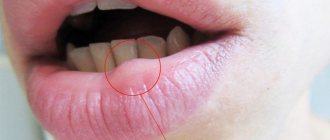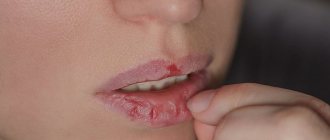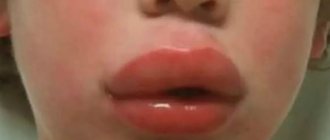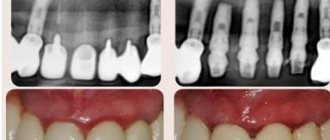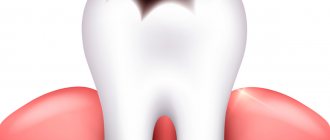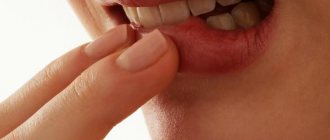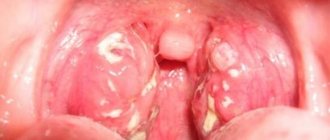Dermatovenerologist
Khasanova
Alina Rashidovna
9 years experience
Make an appointment
Patients often consult a doctor complaining of inflammation in the red border or mucous membrane of the lips. In most cases, a specialist diagnoses “cheilitis”. This is the name for tissue inflammation, which manifests itself in the form of redness, peeling, the appearance of purulent crusts and weeping ulcers. Any attempt to open the mouth when eating or communicating causes sharp pain associated with tissue damage. Without proper treatment, the disease persists for a long time, causing the patient a lot of physical and aesthetic inconvenience. For young people, the prognosis after clinical treatment of cheilitis is completely favorable, but older patients may encounter its complications in the form of leukoplakia and the onset of the oncological process.
Reasons for development
In the clinical practice of most specialists, there are cases where cheilitis on the lips developed on its own or was a side effect of a serious disease of the internal organs or damage to the mucous membrane. Among the most likely causes of the development of the disease are:
- inflammation of the mucous membrane with dermatoses, erythematoses or lichen planus;
- infectious diseases: syphilis, tuberculosis, etc.;
- psoriasis and other skin problems.
Among the unfavorable external factors, it is worth noting an excessive amount of ultraviolet radiation, strong wind, flows of cold or hot air from climate control equipment or ventilation in industrial premises. Signs of cheilitis are often observed in people who work in open areas in direct sunlight.
A separate group includes manifestations of allergic cheilitis, which developed after contact of the lip mucosa with aggressive chemicals or prolonged exposure to ultraviolet radiation. Sometimes doctors observe the clinical picture of secondary cheilitis, when the development of the disease is caused by eczema, neuritis of the facial nerve, pathologies of the muscles and tissues of the facial part of the skull.
General information
Cheilitis (synonyms for jamming, cheilosis) is a disease of the lips, characterized by inflammation of the red border, skin/mucous membrane of the lips, manifested by a change in the structure of their surface and color.
The term “cheilitis” is a generalized name for lip diseases, uniting a large group of lip tissue diseases that differ in etiology and clinical features. The integumentary tissues of the lips are represented by the mucous membrane, skin and red border, which, being related in morphology, differ in the ways of maintaining homeostasis and reaction to external stimuli. The skin of the lips, like the skin of the face, is exposed to various changing external factors (temperature fluctuations, drying, humidity, sun rays, etc.), but the protective ability of the epithelium of the red border of the lips is lower compared to the skin of the face, which is due to the absence of a layer of keratinized cells and pigment that protects against ultraviolet rays. Lips become especially dry when there is a sudden change in temperature and in the sun, and chapped lips occur when exposed to strong winds.
Also, an extremely important condition for ensuring the homeostasis of the integumentary tissues of the lips and their adequate response to external stimuli is the closure of the lips at rest, since the mucous membrane of the lip, adapted to a humid and warm environment, is subject to drying, exposure to sunlight, wind and low temperatures when lip closure is disrupted. The main reasons that contribute to impaired lip closure include: breathing through the mouth, pathology of the bite, impaired tone of the orbicularis oris muscle, bad habits (thumb/tongue sucking, lip biting), short frenulum.
The condition of the red border of the lips is largely determined by the condition of the gastrointestinal tract. Thus, cheilitis in patients with chronic gastrointestinal diseases occurs in 22.8-32.5% of cases, and cracked lips in 3.5-12.0%. The aggravating influence of a number of somatic diseases on the occurrence/course of cheilitis ( hepatitis , gastritis , colitis , cholecystitis ), as well as diseases of the cardiovascular, respiratory and endocrine systems, which have a negative impact on the condition of lip tissues, which contribute to the development of cheilitis, has been revealed.
According to an epidemiological dental examination of the general human population, cheilitis (seizures) in adults is diagnosed in 3.9% of subjects, while the most common pathology of the red border of the lips is exfoliative cheilitis (32% of cases). The disease often has a long-term recurrent nature.
The specific area of the lips includes the corners of the mouth. When the tone of the cheek muscles/fragments of m. is weakened. orbicularis oris, their physiology is disrupted, which leads to incomplete sealing of the lips and accumulation of saliva/food in the corners of the mouth, and a slight inward turning of the red border areas contributes to their maceration and subsequent infection of the areas of the “wet” corners of the mouth, causing inflammation in the corners of the lips.
Conventionally, cheilitis is divided into:
- primary cheilitis (exfoliative, meteorological, allergic-contact, actinic, glandular), occurring in the form of an independent disease;
- secondary (symptomatic) cheilitis , which is one of the manifestations of various diseases (eczematous, atopic).
Symptoms and signs depending on the type of cheilitis
The accepted classification of cheilitis makes it possible to clearly establish the type and causes of the disease, as well as to identify the characteristic signs of the pathological process:
- Exfoliative cheilitis is localized on the red border of the lips. It has a clear gender link: it occurs more often in women. The main symptom is peeling of the lips due to neurological disorders: stress, depression, anxiety. Often the inflammatory process develops against the background of hyperthyroidism, or intense activity of the thyroid gland. The danger of exfoliative cheilitis is its ability to be inherited as a genetically fixed change in the body’s immune system.
A feature of exfoliative cheilitis is localization only on the red border of the lips, while the mucous membrane and skin around the mouth remain intact. In most cases, only part of the border is affected, while areas at the corners of the mouth usually retain their appearance. If a patient has dry skin, he often complains of tightness of the lips, the appearance of scales, and a burning sensation. It is almost impossible to completely cure exfoliative cheilitis. The disease proceeds along a sinusoid, sometimes exacerbating, sometimes disappearing under the influence of medications and external factors. Without medical supervision and if you refuse to take a course of treatment, large bleeding crusts form on the lips, which cause discomfort during conversation and eating.
- Glandular cheilitis develops against the background of pathological proliferation of the salivary glands. A humid environment creates favorable conditions for pathogenic microorganisms, as a result of which the mucous membrane becomes easily infected. If the pathology of the salivary glands is congenital, the probability of developing glandular cheilitis is 100%. The risk group also includes patients with dental problems: untreated caries, periodontitis, tartar, etc.
In some cases, glandular cheilitis develops as a result of damage from waste products and the breakdown of pathogenic microorganisms. The disease is more often diagnosed in patients over 30 years of age and is localized on the lower lip. Primary symptoms are dry lips and the appearance of painful cracks. Usually these symptoms are ignored, and attempts are made to combat them with local cosmetic products. Without treatment, the problem worsens: erosions and bleeding wounds appear at the site of cracks. Involuntary licking of dry lips aggravates the pathological process, which leads to their further dryness.
- Contact allergic cheilitis is caused by exposure to an external allergen. This could be the chemical composition of lipstick, microorganisms on the surface of pencils or pens, which the patient is accustomed to often holding in his teeth during work or creative activities. Cheilitis is considered an occupational disease among musicians who are forced to hold the mouthpieces of instruments in their mouths for a long time. The symptoms of this type of pathology are quite common. Patients complain of itching, swelling, burning and inflammation of the lips. After prolonged contact with the allergen, blisters appear on the skin, the rupture of which opens small ulcers and erosions. In the chronic stage, the disease makes itself felt only with minor itching and peeling.
- Meteorological or actinic cheilitis is a reaction to weather conditions. For a sensitive organism, radiation, wind, cold or solar radiation are equally dangerous, provoking the appearance of characteristic symptoms: burning and itching, large crusts and erosion of the mucous membrane. With prolonged exposure to unfavorable climatic factors, the formation of small bubbles with liquid contents is possible. The dry form of cheilitis is considered the most dangerous for patients. Its first symptoms in the form of itching and burning are harmless. However, with prolonged development and lack of treatment, malignancy is possible - the degeneration of affected cells into a malignant formation.
- Atopic cheilitis is a type of skin disease: atopic dermatitis and neurodermatitis. The disease develops against the background of an allergic predisposition of the body, which reacts to cosmetics, perfumes, food and exposure to pathogenic bacteria. In addition to the usual symptoms, there is dryness and damage to the skin in the corners of the mouth, and intense peeling of the face.
- Hypovitaminous cheilitis develops against the background of a lack of B vitamins in the body. Patients usually complain of dryness and burning of the tongue and lips. Vertical cracks and small peeling scales are visible on the skin. The tongue increases in size, and teeth marks become visible on it.
Are you experiencing symptoms of cheilitis?
Only a doctor can accurately diagnose the disease. Don't delay your consultation - call
Diagnostics
In the process of diagnosing this disease, the key task of a specialist is to differentiate exfoliative cheilitis from other diseases that are similar in external manifestations.
Thus, the dry form of cheilitis in the diagnostic process is compared with the following diseases:
- meteorological cheilitis,
- atopic cheilitis,
- contact allergic cheilitis.
The exudative form requires differentiation with the following diseases:
- exudative form of actinic cheilitis;
- eczematous cheilitis;
- erosive-ulcerative form of lupus erythematosus.
Treatment of various types of cheilitis
The course is developed taking into account the type of diagnosed disease and the general condition of the body.
- For exfoliative cheilitis, additional consultations with a neurologist and neuropsychiatrist are recommended. The patient is prescribed a course of sedatives. Effective methods of local treatment include laser therapy, ultrasound or radiation therapy, and the use of moisturizing cosmetic creams and ointments. According to indications, hormonal medications and vitamin complexes are prescribed.
- Glandular cheilitis is removed with anti-inflammatory ointments. Local treatment consists of cauterization or desquamation of enlarged salivary glands, and during the rehabilitation period, the use of drugs to eliminate dryness or excess moisture of the mucous membrane.
- When treating atopic cheilitis, the goal is to eliminate any irritating factors. The local course is based on the use of anti-inflammatory and anti-allergic drugs in the form of external ointments. Patients are also recommended to have a hypoallergenic diet that excludes the consumption of fish, citrus fruits, spicy foods and alcohol.
- For meteorological cheilitis, treatment tactics include taking vitamin preparations, using local healing agents and ointments with a high UV filter.
Timely initiation of treatment and the patient completing its full course guarantees relief from the unpleasant symptoms of cheilitis with a long-term effect.
Cheilitis in children
Children of almost any age, including teenagers, suffer from seizures especially often. At risk are children 6–8 years old and adolescents in puberty, when complex psychophysiological changes occur in the body. catarrhal / exfoliative cheilitis occurs more often . Candidal cheilitis in infants is often a manifestation of candidal stomatitis (thrush). The reasons for the appearance of jams in children may be the consumption of unwashed vegetables/fruits, the use of dirty dishes, frequent hypothermia/colds, and insufficient oral care. In children under one year of age - sucking on poorly treated breasts, nipples, toys/dental rings, during which increased salivation occurs with the development of skin maceration.
The causes of seizures in a child are often due to generalized pathology of the skin, such as neurodermatitis , eczema , allergic diathesis , or hypovitaminosis due to improper feeding of children. Frequent reasons for the formation of congestion in the corners of a child’s mouth are bad habits in the form of frequent biting/licking lips, biting a pencil, pen, thumb sucking, etc. (Fig. below).
An important factor in the appearance of jams in the corners of the mouth is the prolonged exposure of children to the street (in the wind, sun), where the mucous membrane of the lips is dried out. Seizures in a child can be a manifestation of allergic reactions, streptococcal infection of a cracked corner of the lips, or vitamin deficiency.
Treatment of seizures in a child is carried out according to the same principles as the treatment of adults. However, Dr. Komarovsky does not recommend immediately resorting to potent drugs if the typical course of seizures in a child is uncomplicated. You should first use tea tree oil, aloe juice, a warm brewed green tea bag, oak bark infusion; at the stage of crust appearance - sea buckthorn oil, rosehip oil, oil solutions of vitamin E; For pain relief, it is recommended to use children's Kalgel . To eliminate vitamin deficiency, a course of taking a children's vitamin complex ( Complivit , Alphabet ) is recommended. As a rule, such actions allow you to cure jams in a child, however, if there is no effect or their frequent occurrence is noted, you should consult a doctor.
Herpetic
It is necessary to distinguish the manifestations of herpetic cheilitis from lip cancer. Despite the fact that in both diseases ulcerative lesions and dark brown crusts appear, the removal of which leads to bleeding, in the first case a striking distinctive feature is the formation of small blisters, after opening which erosions form. The appearance of blisters is accompanied by increased itching and burning in the area of inflammation. If left untreated, acute herpetic cheilitis can become chronic with frequent exacerbations.
Glandular
The main difference between glandular cheilitis is the presence of small red dots (enlarged hypertrophied salivary glands) on the red border of the lips. Droplets of salivary fluid are constantly released from these channels, which irritate the skin and provoke an inflammatory process, as well as drying out of the epithelium, the formation of cracks and erosions.
The disease itself appears as a result of gene abnormalities, or against the background of serious diseases. Treatment with drugs rarely gives a positive result, so most often the hypertrophied glands are removed surgically.
Chronic
The presence of chronic cheilitis in a patient indicates that at one time, due attention was not paid to the treatment of the acute form. The development of this form can also be caused by previous infectious diseases caused by yeast infections, streptococci and staphylococci, as well as injuries or hormonal imbalances.
Treatment of the chronic form of the disease is determined based on the cause of its formation. Types such as Miescher granulomatous cheilitis, streptococcal, glandular and meteorological cheilitis can become chronic.
Atopic
This disease is one of the symptomatic manifestations of atopic dermatitis. Characteristic signs are redness, slight swelling, itching, peeling of the skin in the red border area, as well as the spread of the inflammatory process to the corners of the lips, where cracks often form.
The cause is considered to be genetic abnormalities and poor heredity. By puberty, atopic cheilitis can heal itself or go into remission, but recurrent seasonal lesions cannot be ruled out. Allergens can be food, cosmetics, medications and many other factors.
Prevention
Preventive measures are determined by the specific type of cheilitis, for example:
- Prevention of actinic / meteorological cheilitis comes down to eliminating provoking factors: ultraviolet radiation, wind, exposure to low temperatures, for which appropriate hypoallergenic photoprotective creams and hygienic lipstick are used, which are applied to the lip area before leaving the house. It is also necessary to promptly treat general somatic pathologies of the gastrointestinal tract, since very often actinic cheilitis is one of the manifestations of such diseases.
- Prevention of the development of atopic cheilitis is based on strengthening the immune system, proper nutrition, and timely treatment of chronic diseases. If you are predisposed to allergic reactions, it is important to exclude from the diet foods that can cause sensitization of the body, avoid contact with allergens (dust, medications, pollen, etc.), and reduce the amount of carbohydrates in the diet.
- Prevention of angular cheilitis in children comes down to ensuring sufficient oral hygiene, compliance with personal hygiene requirements (preventing the use of common items: dishes, towels, hand washing), eliminating bad habits, good nutrition (preventing hypovitaminosis), strengthening the immune system .
Eczematous
This type of cheilitis is a symptomatic manifestation of eczema, an inflammatory process on the surface layers of the epithelium caused by stress or allergic reactions. In the acute stage, eczematous cheilitis is accompanied by redness, burning, itching, swelling and pain in the lips. In addition, the acute course of the disease is often accompanied by the formation of vesicles, weeping blisters and crusts. When transitioning to the chronic form, swelling and hyperemia decrease, but infiltration increases, scales and nodules form. The main treatment for eczematous cheilitis is to take sedatives and antihistamines.
1.2. Use of computer capillaroscopy in medicine
Capillaries play a key role in maintaining homeostasis in the body, providing tissues with oxygen, nutrients and metabolic products between tissues and the bloodstream. They are the first to respond to the influence of environmental factors and changes occurring in central hemodynamics. Microcirculation parameters are used to diagnose various diseases and identify prognostic signs [30].
In dentistry, computer capillaroscopy has begun to be used in the diagnosis of periodontal diseases and to monitor the effectiveness of their treatment. Disruption of microcirculation in periodontal diseases is accompanied by shifts in the parameters of vascular-platelet and coagulation hemostasis, caused by local tissue coagulation factors. Disorders of microcirculatory hemostasis are not specifically isolated, but to a certain extent reflect the nature of inflammatory and destructive processes in periodontal tissues [8].
Under the guidance of prof. E.K. Krechina defended a number of dissertations devoted to the study of microcirculatory disorders of periodontal tissues in various forms of periodontitis [21, 26].
It has been established that changes in the hemodynamics of tissue blood flow in the initial stages of inflammatory diseases are moderate (linear and volumetric blood flow velocities are reduced by 22-40%). As the severity of the inflammatory process in the periodontium increases (moderate and severe periodontitis) and with periodontal disease, changes in the hemodynamic parameters of tissue blood flow become pronounced (blood flow velocity decreases by 56-80%) [14].
When assessing the reaction of the vascular bed against the background of various diseases of the oral cavity, hemodynamics is still used in isolated cases. A study of the microvasculature in patients with glossalgia revealed in a significant number of cases spastic and spastic-atonic syndromes of capillary hemodynamics, which indicated a violation of the peripheral blood supply to the oral cavity at the level of the microvasculature (changes in metabolism and hypoxia). Subsequently, this served as the basis for prescribing anti-inflammatory and antioxidant therapy [10].
Studies have found that an increase in vascular density in lichen planus (LP) may be associated with the mechanism of angiogenesis and serves as an indicator of the development of the pathological process. In the diagnosis and monitoring of the development of LP, capillaroscopy plays an important role, as it allows one to determine all vascular changes in patients suffering from this pathology. The method makes it possible to evaluate differences in the vascular pattern in healthy people and people suffering from LP with high and low degrees of basement membrane degeneration [15, 66, 72, 79].
The experiment involved studies of the microvasculature using a helium-neon laser (HNL) for diseases of the oral cavity. The effect of GNL on the vascular system of tissues is manifested by an increase in vascular tone and fibrinolytic activity of the blood. This method has been widely used in the treatment of periodontal diseases, Melkersson-Rosenthal syndrome, etc. [3].
Thus, studies of microhemodynamics in all kinds of chronic inflammatory processes, such as diseases of the lips (cheilitis), are diagnostically and prognostically promising.
List of sources
- Anisimova I.V., Nedoseko V.B., Lomiashvilli L.M. Diseases of the mucous membrane of the mouth and lips (clinic, diagnosis). - St. Petersburg: MEDI publishing house, 2005. - 92 p.
- Borovsky E.V., Mashkilleyson A.L. Diseases of the mucous membrane of the mouth and lips. - M., 2001. - 320 p.
- Tsvetkova L. A., Arutyunov S. D., Petrova L. V. and others. Diseases of the mucous membrane of the mouth and lips: a textbook. - M.: MEDpress-inform, 2005. - 208 p.
- Antonyev, A.A. About occupational contact cheilitis / A.A. Antonyev, I.V. Gerasimenko // Bulletin of dermatology and venereology. - 2006. - No. 1. - P. 56-60.
- Petrova, JI.A. Differential diagnosis of cheilitis / J1.A. Petrova // Doctor. - 2007. - No. 11.-S. 12-14.

